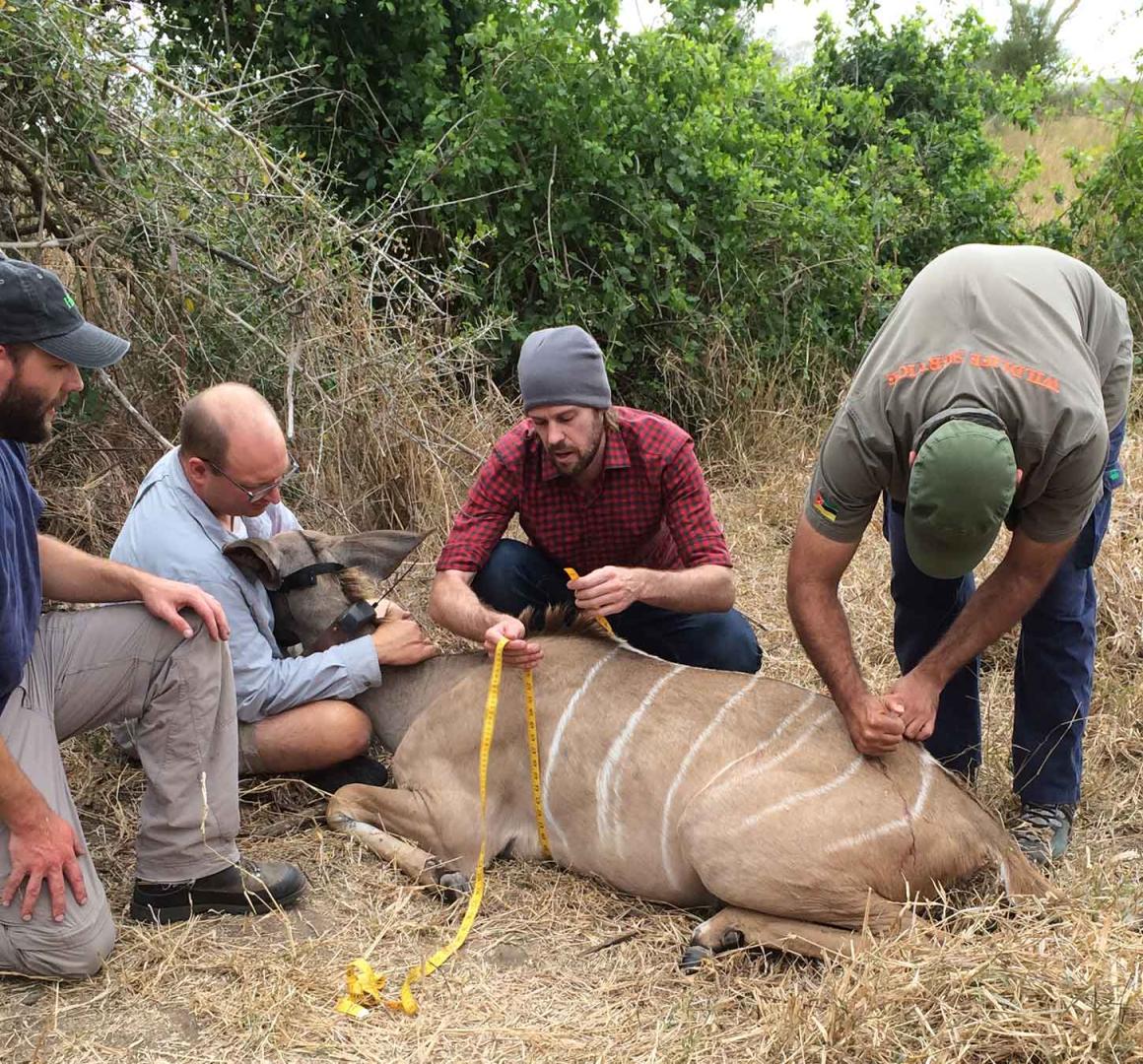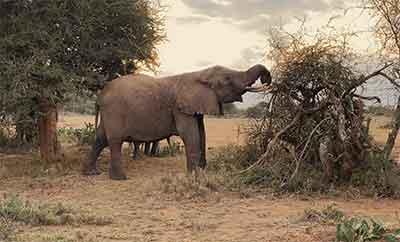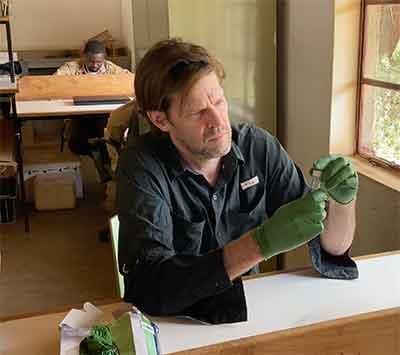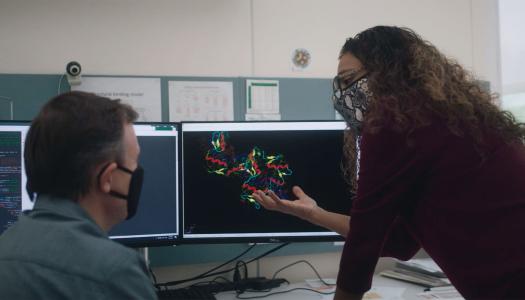With DNA toolkit, Rob Pringle is learning how to rebuild broken ecosystems
Watch the new ‘Dare to Venture’ video to see how researchers are helping to heal habitats.

Rob Pringle measures a tranquilized kudu that has been fitted with a GPS collar while the park veterinarian (right) in Mozambique’s Gorongosa National Park removes the dart. The collected data are used to monitor the movements, diets and condition of animals throughout Gorongosa to understand how they respond to climate change and the restoration of the park.
In the beginning, Rob Pringle didn’t have a choice. His grandparents were passionate naturalists who loved exploring the outdoors with him and his younger sister, and his parents’ idea of vacations when he was growing up in Ann Arbor, Michigan, were backpacking adventures and camping in the mountains. They are fond memories today, but Pringle recalls a certain amount of ambivalence — especially when such excursions interrupted his summers and prevented him from keeping up with the baseball season.
That early exposure to the beauty and wonder of nature nevertheless made a powerful impression. When he was around 10 years old, Pringle read an article in a children’s magazine about the destruction of the Amazon that cited how much rainforest was disappearing every minute, every hour and every day. “I felt cheated because I wanted to go and see those wonderful places, and it seemed like it would all be gone by the time I was old enough,” he said. “It made me want to cry.”
Three decades later and 7,720 miles away, Pringle is leading a team of Princeton researchers at Mpala Research Centre in Kenya, a Princeton-affiliated conservancy that is home to African elephants, buffalo, Grevy’s zebras, plains zebras, impalas and smaller antelopes called dik-diks, among other species. The researchers’ four-wheel drive splashes through a puddle and skids to a stop near a wire fence, not far from a trail of unmistakable muddy footprints that lead to a family of magnificent elephants enjoying their breakfast. The fences keep the elephants out of certain sectors of the conservancy, so that the researchers can study how those habitats develop in their absence.

“The messaging that I had internalized growing up was that once it’s gone, it’s gone forever,” said Pringle, professor of ecology and evolutionary biology. “But the conservation vision that moves me today is that we can actually rehabilitate and rebuild some of these wilderness areas that are so tremendously important for climate stabilization and biodiversity. Mpala allows us to tinker with stuff, to actually do experimental manipulations that help us understand cause and effect, so we can get at this question of how to rejuvenate ecosystems that have been broken or badly degraded.”
Mpala is a living laboratory — 49,000 acres that have been attentively maintained for decades. But Pringle’s research in Africa is also fueled by another ecosystem, one that was on the brink of annihilation. Once again, he learned about it in a magazine article. In 2009, The New Yorker featured a story on Gorongosa National Park in central Mozambique, a nation devastated by 16 years of civil war. The populations of keystone species in the park — such as wildebeest, hippo, buffalo, elephants and lions — collapsed as armies battled and hungry survivors hunted whatever wildlife was left.
Pringle, inspired by one of his professors at the University of Pennsylvania who had helped to restore tropical forests in Costa Rica, saw Goronogosa as a unique opportunity. Shortly after he completed his Ph.D in biology at Stanford, he traveled to Mozambique to study the ecological consequences of extinction, species invasions, climate change and other human disturbances. At Gorongosa, he encountered a skewed ecosystem with “the wrong species in the wrong places.”
“Shy forest antelopes were wandering around the open plains in broad daylight, and baboons were sleeping on the ground because there were no carnivores around,” Pringle said. “Half of the female elephants were missing their tusks. It was still a beautiful place, but not totally healthy or balanced.”
To revive a damaged ecosystem, it helps to know the answers to some basic questions. Like, what do the animals eat? It turns out that nobody really knew. In one classic study of elephants’ diet, their chief food was identified only as “grass.” But what kind of grass?
“Even if you could stand right next to the animal, it would be hard to figure out what exactly it was eating, much less than in what amounts,” Pringle said. “So this is an enormous, astonishing hole in our understanding of the most basic thing you could ever want to know about any animal — what it eats. And that’s a major problem for the field of ecology as a whole, as well as for conservation and restoration.”
Pringle set out to determine animal diets down to a granular level using a revolutionary technique called DNA metabarcoding, which identifies the DNA of a mix of grass and plants in 250 million lines of genetic code. “It’s not just sequencing a string of DNA, because we’re taking a soup of DNA and sequencing all of it at once,” Pringle said.

Pringle and his team collected fecal samples from animals at Gorongosa and Mpala, preserved them, and brought them back to the lab for analysis. Building online databases of plant and animal DNA, they were able to map out the ecosystem’s food webs. Improved technology and methods have led Pringle’s lab to even more precise and revealing molecular measurements of environmental DNA (eDNA), which includes cellular material shed by animals. “Nature is one giant crime scene, the DNA is everywhere, and we are the forensic investigators,” Pringle said. “We can wash off the surface of leaves and rocks to figure out which species of insects have been there, which species of lizard were sitting on this tree, which species of snails live in that waterhole.”
The technology demonstrated its potential at Gorongosa, where authorities were grappling with how to eradicate catclaw mimosa, an invasive weed from Central America that was choking swaths of the African savannah. “DNA metabarcoding showed that this plant was many of the herbivores’ No. 1 food, making up between 40 and 70 percent of their diets, so as long as the herbivores stay abundant, the invasive plants will stay under control and aggressive, expensive intervention wouldn’t be necessary,” Pringle said. “To a large extent, nature recovers itself if given the space, but there’s a lot that we can do to help that process along, help it move faster and avoid wasting time, money and resources that could be spent better on other things.”
Not long ago, the primary way that ecologists studied animal diets was to sift through the contents of dead animals’ stomachs. Even then, the results could be inaccurate or misleading. With metabarcoding technology, though, Pringle’s lab is working to build a sharable database of thousands of samples that document the diets of large herbivores across more than a dozen African ecosystems in 10 countries, from common antelopes to critically endangered elephants and rhinoceroses.
“Fifteen years ago, it wasn’t possible to do what we’re doing now, and five or ten years from now, we should be able to do it with something the size of an iPhone,” Pringle said. “We’re on the cusp of a revolution in our ability to gain a mechanistic understanding of how species coexist, how ecosystems work, and how to patch them up when they get damaged.”
There are a million reasons to study molecular ecological data that illustrate food networks in order to preserve stressed habitats and forecast the impact of environmental disturbances. But as a father of a two-and-a-half-year-old, Pringle’s clinical lens has broadened.
“Seeing these animals in nature is extremely powerful, and there’s a component of humanity’s evolutionary trajectory and role on this planet that is bound up in preserving these charismatic animals and their habitats,” he said. “These majestic species inspired me to want to work in environmental science, and I want them to continue to exist so my daughter is able to have the same sorts of inspirations that I had.”
Venture Forward is a mission-driven campaign that is focused on Princeton University’s strengths in the liberal arts, pushing the bounds of knowledge across disciplines, and collaborating to champion inclusion, the humanities, science, art, public policy and technology.


